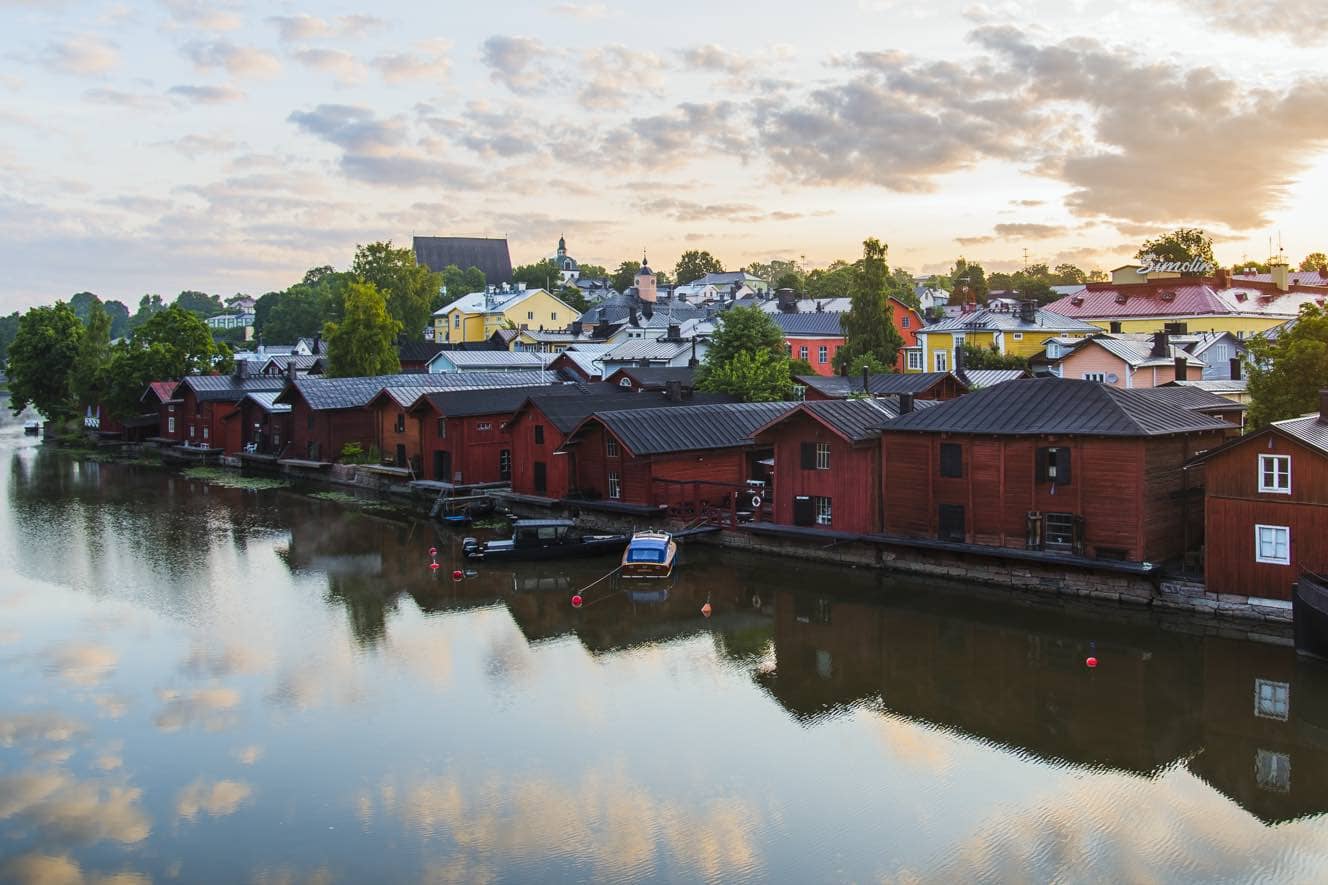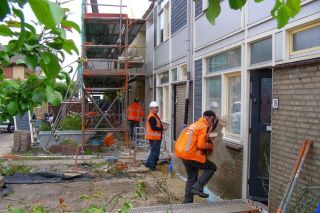
www.buildingsandcities.org/insights/commentaries/high-density-urban.html
Is High Density Necessary for Future Urban Life?

Smaller cities and towns can offer attractive forms of urbanism and quality of life. Alternative criteria to density are needed.
Mari Vaattovaara (University of Helsinki) critiques the current emphasis on city
density and size as desirable quality indicators. If emphasis is placed on the quality of physical
environment or quality of life, then smaller cities and towns are both viable
and desirable alternatives.
Density and hi-tech criteria
Urban life has been praised enormously during the last 50 years by scholars around the world. It is linked to high-rise buildings and growing megacities, to the possibilities for joy, exchanging ideas and generating remarkable innovations. Growth, agglomeration benefits and highly educated residents are described as the core elements of success. The combination of these three elements would create conditions where "people are more productive when they work in densely populated areas" as has been stressed by the urban economist, Edward Glaeser (2011, p. 6):
"Cities are the absence of physical space between people and companies. They are proximity, density, closeness. They enable us to work and play together, and their success depends on the demand for physical connection."
Thus, zoning allowing high-rise buildings in the most preferred locations has been a general recipe of growth and production in cities (see Peck 2016 for a detailed critique). Less has been discussed about the other qualities.
The general emphasis has been on the overwhelming benefits of cities - and indeed, many of the qualities of big cities are improving. Better air-quality, greened rooftops, improving safety are some positive changes to occur during the last decades. Furthermore, the new technological solutions are adding to the benefits of cities. Forbes (2019), for example, recently described "6 ways smart cities are improving everyday life". These all were based on technologies e.g. free flow of information between interconnected devices, smart traffic lights, on-demand parking, real-time emergency response, infrastructure monitoring, smart lighting and waste management.
The new concepts of technological development, energy solutions and recycling structures are influencing urban ideals, planning documents and masterplans. Reading through some of the masterplans directing the building of new housing areas in Finland - it is clear that for example 5G technology has been included as one of the new innovative qualities of new plans. One of the most extensive zoning projects of Espoo, Finland is described as:
"The goal for Kera (a new city district) is to become an international example of circular economy. The existing railway traffic and the ongoing development of 5G technology in the area make it possible to implement cutting-edge IoT and mobility solutions already in the construction phase. [The aim is] to create a pleasant, safe and clean district based on go-creation and circular economy".
Source: Espoo City website
What other factors have we forgotten during the speed of growth? What and where are the agglomeration benefits we find? Is the time of smaller cities over?
Towards alternative criteria
What does this all mean? Have the issues of density, agglomeration benefits, 5G technology and circular economy become the drivers of urban life and construction of the built environment? Based on these qualifications, what kind of neighbourhoods are we expected to imagine? What qualities of urban life are we strengthening? What qualities have been put aside or even neglected? And finally, how do these new qualities manifest themselves into blocks, neighbourhoods and cities? Is there any future for small cities and even villages?
The qualities of urban life cultivated by the built environment need urgent reconsideration. Both the planning principles and the whole idea of cities should be revisited. The connection between urban life, preferences and the settlement sizes is far from clear or understood. Mike Batty, the pioneer of the idea of cities as complex systems has raised an important yet basic question: "Where are the physical borders of cities if they merge into each other, what then is a city if its wealth is generated globally?" (Batty, 2020). I would argue for the very basic "learnings" from the urbanizing world need debate and reconsideration. What kind of built environment do we need to have an urban lifestyle? To get unique services, hipster clothing or just café latte? Or to work in a global company with the smartest technologies?
As has been described by several scholars, one of the clear and powerful ways to change the perspectives, policies and practises is through the flow of ideas and frames of reference. By creating new concepts and imaginations - discourses - we can indeed change the practices as well as the ideal of the desired outcomes.
Density has suddenly become a generally used synonym for positive urban development, without sufficient consideration of what density actually means. The relative easiness of measuring density makes it a prime source of confusion and misunderstanding. Density is also an obsolete concept due to our current mobile lifestyle. According to the standard definition, density is a measurement that compares the amount of matter contained within an object. Never since the introduction of motorized transport has the density ideology been so vulnerable to exploitation. For example the slogan "A compact city is a contact city" was introduced by Pentti Murole in the 1960s. This paved the way for Finnish suburban development from the early experiment with the creation of new town Tapiola providing the suburban high-rise developments that were utterly different from the original urban ideal. Despite the initial utopia of a city reborn, the density ideal only became more distorted in the housing boom of the 1970's and resulted in a suburban development that could not really retain any of the qualities for the economic or social activity. As I wrote with Franz Oswald and Anssi Joutsiniemi (2019) "we may conclude that the container for measuring density and container for daily activities no longer went hand in hand - changes in accessibility took over the assumed favor of proximity and left density as a mere half-baked ideal." Based on our analysis of Helsinki region and also students' research, who were trying to define, analyze and explain qualities of urban life by playing with different densities - we concluded that "the essence of urban and suburban life is not defined in buildings and their contents, in densities but in the spaces in between" We can show how the profound structural feature ofthe suburban fringe, which constitutes most of the contemporary urban - "is this constant 85% openness, which remains a key characteristic of the surroundings regardless of how many storeys we add to the buildings. It cannot be changed by increasing the population or any other type density, and remains decisive for present and future activities".
In his seminal text 'Nothing gained by overcrowding'. Raymond Unwin (1912) observed the same thing. The increased travel speed enabled a vast amount of land for urban development and rendered feasible the entire garden city movement. The possibility to move ten times faster opened up a land supply a hundred times greater than before.
Thus in order to respond to the needs of the people, to meet their expressed preferences, to keep social and economic activities ongoing (especially during a pandemic requiring social distance), the qualities urban life and built environment patterns need rethinking. Instead of economically sound but spatially difficult concepts such as agglomeration benefits, density or 5G networks, it is worthwhile revisiting the old design principles of space, block and neighbourhood. If most of the "urban" consists of openness between buildings within the suburban fringe, then the qualities need more eloquent content and character. Furthermore, the legitimacy of any planning activities should also be based on the evaluation of the outcomes (see Rosanvallon 2011). Are the newly built environments progressive or regressive in their direction?
Making smaller cities and towns viable
The economics of big cities and high densities have led to high land prices. In turn, housing has become unaffordable in many cities. In response, the trend has been towards minimizing the apartment sizes, towards putting people into the "shoeboxes". Oswald & Baccini (2003) argued that good urban design must be rooted in identity, diversity, flexibility, self-sufficiency or resource efficiency. To this, must also be added affordable home ownership with preferably a front door giving access directly to the street or front garden, as stated by many in questionnaires.
In contrast to the recent discussions highlighting megacities, other possibilities deserve attention. As an option for healthy environment, where access to services and "café latte" are possible the potential of small and middle-sized settlements deserve re-evaluation. If qualities are taken as the key principle for planning and development for sustainable future, the most desired blocks and neighbourhoods might also be found in small towns and villages. Already before the current pandemic, the renaissance of small towns was emergent in many countries.
The last few months has been an experiment of living and working at a distance. Although the lock-down has caused many negative outcomes for the economy, many firms have also turned wasted commuting time into efficiency and productivity gains for the firm. The benefits fostering the economy are not so much outcome of major agglomerations, but in the time saved on daily mobility.
The key question should be on to how to address the human qualities and individual preferences to secure the inclusiveness of the society for all. Density is not a goal in itself, even if it works well in some locations. Too much emphasis has been placed on making large cities work. Instead, or in addition, discussion and research should focus on defining the preferred qualities. The emerging new perspectives and new design and planning principles would also gain legitimacy from the evaluation of the outcomes. This would foster identity, diversity, flexibility - and maybe also notice that many of the qualities needed - are already present in smaller cities and towns.
Many smaller cities and towns, in good locations, are vibrant, attractive places to live and work. It is very possible for these settlements to offer similar qualities to large cities - and even more, if just right (old?) qualities are placed back to the agenda. A national discussion has been initiated in Finland, but other countries would also benefit from developing their own dialogue about the value of urban life in smaller cities and urban design principles.
References
Batty, M. (2020). The Coronavirus crisis: What will the post-pandemic city look like? Environment and Planning B: Urban Analytics and City Science, 47(4). doi: 10.1177/2399808320926912
Forbes magazine. (2019). 6 ways smart cities are improving everyday life. https://www.forbes.com/sites/insights-teradata/2019/10/01/6-ways-smart-cities-are-improving-everyday-life/
Glaeser, E. (2011). Triumph of the city: how our greatest invention makes us richer, smarter, greener, healthier, and happier. New York: Penguin Press.
Joutsiniemi, A. T., Oswald, F., & Vaattovaara, M. K. (2018). Excursions into suburban density. In Confused Suburban Identities A Case Study of Helsinki Region. Helsinki: Urban Studies and Planning / Master's Programme of Urban Academy in Helsinki. ISBN: 978-951-51-4194-1
Oswald, F., Baccini, P. & Michaeli, M. (2003). Netzstadt: designing the urban. Basel: Birkhäuser.
Peck, J. (2016). Economic rationality meets celebrity urbanology: exploring Edward Glaeser's city. International Journal of Urban and Regional Studies. 40: 1-30. doi:10.1111/1468-2427.12321
Rosanvallon, P. (2011). Democratic legitimacy: Impartiality, reflexivity, proximity. Princeton: Princeton University Press.
Unwin, R. (1912). Nothing gained by overcrowding!: How the garden city type of development may benefit both owner and occupier. London: Garden Cities and Town Planning Association.
Latest Peer-Reviewed Journal Content
Built environment governance and professionalism: the end of laissez-faire (again)
S Foxell
Co-creating justice in housing energy transitions through energy living labs
D Ricci, C Leiwakabessy, S van Wieringen, P de Koning & T Konstantinou
HVAC characterisation of existing Canadian buildings for decarbonisation retrofit identification
J Adebisi & J J McArthur
Simulation and the building performance gap [editorial]
M Donn
Developing criteria for effective building-sector commitments in nationally determined contributions
P Graham, K McFarlane & M Taheri
Reimagining circularity: actions for optimising the use of existing buildings
R Lundgren, R Kyrö, S Toivonen & L Tähtinen
Effective interdisciplinary stakeholder engagement in net zero building design
S Vakeva-Baird, F Tahmasebi, JJ Williams & D Mumovic
Metrics for building component disassembly potential: a practical framework
H Järvelä, A Lehto, T Pirilä & M Kuittinen
The unfitness of dwellings: why spatial and conceptual boundaries matter
E Nisonen, D Milián Bernal & S Pelsmakers
Environmental variables and air quality: implications for planning and public health
H Itzhak-Ben-Shalom, T Saroglou, V Multanen, A Vanunu, A Karnieli, D Katoshevski, N Davidovitch & I A Meir
Exploring diverse drivers behind hybrid heating solutions
S Kilpeläinen, S Pelsmakers, R Castaño-Rosa & M-S Miettinen
Urban rooms and the expanded ecology of urban living labs
E Akbil & C Butterworth
Living with extreme heat: perceptions and experiences
L King & C Demski
A systemic decision-making model for energy retrofits
C Schünemann, M Dshemuchadse & S Scherbaum
Modelling site-specific outdoor temperature for buildings in urban environments
K Cebrat, J Narożny, M Baborska-Narożny & M Smektała
Understanding shading through home-use experience, measurement and modelling
M Baborska-Narożny, K Bandurski, & M Grudzińska
Building performance simulation for sensemaking in architectural pedagogy
M Bohm
Beyond the building: governance challenges in social housing retrofit
H Charles
Heat stress in social housing districts: tree cover–built form interaction
C Lopez-Ordoñez, E Garcia-Nevado, H Coch & M Morganti
An observational analysis of shade-related pedestrian activity
M Levenson, D Pearlmutter & O Aleksandrowicz
Learning to sail a building: a people-first approach to retrofit
B Bordass, R Pender, K Steele & A Graham
Market transformations: gas conversion as a blueprint for net zero retrofit
A Gillich
Resistance against zero-emission neighbourhood infrastructuring: key lessons from Norway
T Berker & R Woods
Megatrends and weak signals shaping future real estate
S Toivonen
A strategic niche management framework to scale deep energy retrofits
T H King & M Jemtrud
Generative AI: reconfiguring supervision and doctoral research
P Boyd & D Harding
Exploring interactions between shading and view using visual difference prediction
S Wasilewski & M Andersen
How urban green infrastructure contributes to carbon neutrality [briefing note]
R Hautamäki, L Kulmala, M Ariluoma & L Järvi
Implementing and operating net zero buildings in South Africa
R Terblanche, C May & J Steward
Quantifying inter-dwelling air exchanges during fan pressurisation tests
D Glew, F Thomas, D Miles-Shenton & J Parker
Western Asian and Northern African residential building stocks: archetype analysis
S Akin, A Eghbali, C Nwagwu & E Hertwich



Latest Commentaries
Building-Related Research: New Context, New Challenges
Raymond J. Cole (University of British Columbia) reflects on the key challenges raised in the 34 commissioned essays for Buildings & Cities 5th anniversary. Not only are key research issues identified, but the consequences of changing contexts for conducting research and tailoring its influence on society are highlighted as key areas of action.
Lessons from Disaster Recovery: Build Better Before
Mary C. Comerio (University of California, Berkeley) explains why disaster recovery must begin well before a disaster occurs. The goal is to reduce the potential for damage beforehand by making housing delivery (e.g. capabilities and the physical, technical and institutional infrastructures) both more resilient and more capable of building back after disasters.